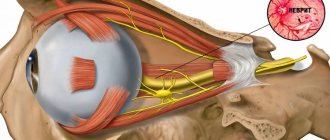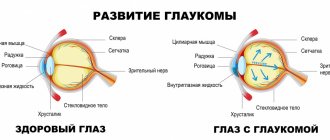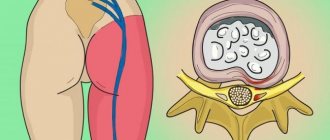Author of the article: Gevorkyan Armine Seyranovna, Ophthalmologist, highest qualification category, member of the Russian Society of Cataract and Refractive Surgeons (RSCRS) and the European Society of Cataract and Refractive Surgeons ESCRS Optic atrophy is an eye disease that is characterized by weakened vision due to the development of pathological processes affecting the nervous part of the organ. In other words, with atrophy, the optic nerve fibers gradually die off, and information from the retina is supplied to the brain in a distorted form. This pathology can occur for many reasons, most of them are associated with the presence of ophthalmological diseases. We will tell you what symptoms the disease has, how it is diagnosed, and what the cost of the operation is.
Optic nerve atrophy: what is it, causes, how to treat
The optic nerve is a kind of “path” along which impulses generated during the perception of images pass. If any part is “blocked”, that is, atrophy occurs, then the image is not conveyed accurately. Unfortunately, this pathology can occur in people of any age. Not so long ago, when doctors diagnosed atrophy, they simply refused to treat the patient. The progressive development of atrophy ended in blindness, as doctors believed that it was impossible to restore the optic nerve tissue.
Modern diagnostic methods have made it possible to study the disease in detail, and ophthalmologists have come to the conclusion that if the fibers are not completely subject to atrophy, then it is quite possible to restore them. It is enough to identify the symptoms in a timely manner and perform surgery. Therefore, if a person’s vision deteriorates, he should immediately contact a specialist. This disease is treatable.
Types of optic nerve damage
The causes of atrophy are considered to be ophthalmological diseases and various pathologies. But there are several main types:
hereditary In case of DNA mutation, the presence of Bourneville syndrome and a number of other diseases, diseases of the optic nerve can manifest themselves as a side effect. Getting rid of symptoms is easy if you eliminate the underlying cause;
acquired. Divided into primary and secondary types. If peripheral neurons are compressed, the primary type of atrophy develops. In this case, the eye disc remains unchanged. If disc swelling occurs, secondary atrophy develops. Also, due to intraocular pressure, glaucomatous form can occur.
There are 3 stages of optic nerve disorder: initial, incomplete, complete. The disease can be stationary or progressive.
Structure and functions performed
The optic nerve is the most important and complex element of the visual apparatus. It is the so-called second pair of cranial nerves, and through them the images received by the retina are sent to the brain structures. This nerve is particularly sensitive; it contains from 800 thousand to 1.7 million fibers, which are axons that belong to the ganglia of the retina.
In terms of its formation and structural features, the optic nerve is not a standard cranial nerve, but a certain accumulation of brain matter located in the peripheral zone and connected with the cerebral nuclei, as well as with the cortex of the cerebral hemispheres.
The processes of the ganglion cell units of the retina are concentrated in the optic disc (also called the papilla or head), located in the organ of vision and abbreviated as the optic disc. Then the bundles formed by the nerve fibers pass through the sclera and create a nerve trunk. Between such bundles are the central artery and vein of the retina (they pass through the disc). Together with these vessels, the optic nerve rushes through the optic canal into the cranial cavity to the brain.
The main function of the optic nerve is the transmission of visual impulses arising due to the work of the retina. It contains photoreceptors (cones with rods) that trigger photochemical reactions, which are then transformed into impulses. These impulses travel through the nerve to the brain, thanks to which a person perceives objects visually, that is, sees them.
Symptoms of optic atrophy
Optic nerve atrophy manifests itself quite clearly, but in children it is more difficult to determine the pathology. If the optic nerve is damaged at an early age, the child may simply not realize that he perceives the world differently. Therefore, you should regularly visit doctors and undergo examinations. There are main symptoms indicating optic nerve atrophy:
- so-called dark spots appear before the eyes, a feeling of interference is created, as if something is in front of the eye in the field of vision;
- Central vision is significantly reduced with primary optic atrophy, which can lead to complete blindness. Therefore, it is necessary to make timely diagnosis and undergo treatment;
- you may notice a narrowing of the field of view;
- Sometimes it becomes quite difficult to distinguish colors.
If at least one symptom appears, this can serve as a bell that indicates the presence of optic nerve atrophy. Remember that in the early stages the treatment process gives tremendous results, up to the complete restoration of the optic nerves. It is necessary to correctly identify the disease and prescribe a treatment package that allows you to restore the nerve. This can be done in our clinic.
Are you experiencing symptoms of optic atrophy?
Only a doctor can accurately diagnose the disease. Don't delay your consultation - call
Causes of atrophy
Optic nerve atrophy often does not occur on its own. It has its own reasons, which include:
- development of dangerous infectious diseases (meningitis, syphilis, herpes);
- serious traumatic brain injuries;
- mechanical damage to visual tissues and fibers;
- diseases that affect the nervous system, these include multiple sclerosis;
- alcohol poisoning: so-called “blindness” from alcohol;
- disruption of circulatory processes, especially in visual tissue;
- oncological diseases that compress part of the nerve and provoke the development of atrophy;
- disturbances in the fusion of skull bones after fractures;
- increased intraocular or intracranial pressure;
- development of glaucoma;
- vascular diseases that disrupt nutritional processes: vegetative-vascular dystonia, atherosclerosis, severe vascular spasms;
- brain diseases.
It is worth noting that optic nerve atrophy can develop even with a common cold. Monitor changes and symptoms. If they appear, you should immediately contact an ophthalmologist. You can lose your sight simply due to inattention to your health. Visit JSC "Medicine" (academician Roitberg's clinic) and undergo a comprehensive examination to find out if the visual fibers are in order. This is also recommended for preventive purposes.
Why is optic nerve atrophy dangerous?
The optic nerve can be thought of as a telephone wire. On the one hand, there is the retina, on the other, the part of the brain responsible for image perception. Inside this “wire” there are a large number of fibers that provide reliable communication. If the fibers begin to tear or become deformed, this bond will deteriorate significantly. If the optic nerve is damaged, it is necessary to select a position in which the image becomes clearer.
Atrophy entails a number of consequences:
- a person ceases to perceive colors;
- blindness develops;
- regular headaches occur;
- there is pain in the eyes;
- the field of view narrows significantly, you have to constantly choose an angle to look around.
There are enough reasons to contact an ophthalmologist in a timely manner and begin the treatment process. There is no need to neglect your health; optic nerve atrophy is quite easy to treat while it is at an early stage.
Read also
Contact lenses/contact correction
Vision is one of the senses through which we learn about the world around us.
Good vision is essential for a high quality of life. The most important characteristic in diagnosis is the acuity… Read more
Red eye
*Red eye syndrome* is a group of diseases that are accompanied by redness or hyperemia of the eye. Redness of the eyes (hyperemia) occurs due to dilation of the vessels of the conjunctiva of the sclera and can...
More details
Blindness
Vision is a unique gift that nature has given us. We can truly appreciate it only when we lose. With a number of diseases, vision loss may decrease, sometimes almost to the point of complete blindness. Often…
More details
Myopia
Vision plays a huge role for a person. Through the eye we experience the entire amazing and diverse world. A person receives 80-90% of information from the surrounding world through vision. Therefore, a huge tragedy...
More details
Perinatal encephalopathy
Perinatal encephalopathy is a frequently encountered concept in the practice of pediatricians and pediatric neurologists! What it is? Literally, “perinatal encephalopathy” means “damage to the brain in the perinatal...
More details
Diagnosis of the disease
Optic atrophy is diagnosed through a series of tests by an ophthalmologist. Additionally, consultation with a number of other specialists, in particular a neurologist and neurosurgeon, may be required. In order to make a diagnosis, the following procedures are performed:
- angiography of cerebral vessels. It allows you to determine the area in which atrophy develops;
- X-ray of the skull. The doctor looks to see if there is compression of the nerves due to bone deformation or other disorders;
- MRI. Allows you to accurately assess the condition of the optic nerve and examine the fibers;
- ophthalmological examination. The structure of the eye disc is studied;
- computer perimetry. The procedure allows us to understand which part of the nerve is damaged.
The doctor may also prescribe a number of other examinations to get a more accurate picture. After this, treatment of optic nerve atrophy begins, as a rule, it is very successful. But it is worth noting that it will not be possible to completely eliminate atrophy and restore the body. The doctor's task is to restore as many fibers as possible. But the earlier the presence of atrophy is determined, the higher the likelihood of success.
For any damage to the optic nerve, treatment is necessary, since ignoring the disease leads to partial or complete loss of vision. Then it will be almost impossible to restore it.
Clinical picture: characteristic signs and symptoms
The main sign of atrophy is deteriorating vision. The partial type of pathology is accompanied by a decrease in severity, and the condition cannot be corrected with glasses or contact lenses. Visual functions can be impaired slowly and at some point remain unchanged, but sometimes the impairment is rapid and significant, leading to disability.
The partial type of progressive atrophy can lead to decreased vision over a period of several days or weeks to several months. Moreover, often with partial atrophy, changes can reach a certain point and stop, as a result of which the functions of the visual apparatus are not completely lost and are preserved to some extent.
Signs of atrophies include:
- reduced visual acuity (this symptom occurs in all cases);
- narrowing of visual fields, tunnel syndrome, in which the area of visibility is partial, as if viewed through a tunnel;
- disturbances in color perception (the sign is a distorted perception of the yellow-blue or red-green part of the color spectrum);
- formation in the field of view of scotomas - “blind” areas falling out of the field of vision;
- impaired reaction of the pupil to light exposure.
The initial stage of the pathology often occurs without symptoms. And the signs detected as atrophy develops can be subjective, that is, assessed by the patient under the prism of his own feelings, which are not always correct. Any objective and obvious symptom of a disorder is identified when making a diagnosis during an examination of the visual apparatus. Reliable signs may be changes in the structure, shade and boundaries of the nerve or its disc, dilated blood vessels.
Which doctors treat atrophy?
Not everyone knows which doctors treat atrophy. Ophthalmologists are involved in restoring vision and getting rid of optic nerve atrophy. They are the ones who identify the disease and help restore vision. But sometimes the services of a neurologist and neurosurgeon are required. These specialists perform a number of procedures necessary for the patient's recovery.
Our clinic employs highly professional specialists with extensive experience who will help get rid of optic nerve atrophy. All that remains is to see a doctor and get medical help.
Diagnostic measures
The doctor will restore and preserve visual functions, as well as cure the underlying disease, only after a comprehensive diagnosis. The diagnosis is made after the following procedures:
- visometry to assess real visual acuity;
- perimetry to analyze the visual fields of the eyes;
- fluorescein angiography to study the structure and functioning of blood vessels;
- checking color perception with special tests;
- ophthalmoscopy to assess the structure and condition of the fundus;
- biomiroscopy to check the condition of different parts of the eyes and identify signs of abnormalities;
- tomography (for analysis of the optic disc): scanning laser or coherent optical;
- electrophysiological studies to determine the sensitivity of nerve fibers;
- X-rays of the skull, MRI or CT scan of the brain to determine signs of changes in neurological status and detect various injuries.
The diagnosis is usually made by an ophthalmologist. But if there are signs of systemic diseases, consultations with specialized specialists may be required: a neurosurgeon, neurologist, rheumatologist, surgeon, oncologist.
Treatment of optic atrophy
Atrophy is called damage to the optic nerve, and experts assure that it is almost impossible to completely restore the organ’s full functioning. This is true, but it is possible to get as close as possible to a successful result. For this purpose, complex treatment of optic nerve atrophy is carried out. The following methods of influence are used:
- Magnetic stimulation. The specialist acts on the organ with an alternating magnetic field. This significantly improves blood supply and activates various metabolic processes in tissues. The healing process is accelerated, this method helps with treatment in the early stages. 10-15 sessions are enough to completely restore vision.
- Electrical stimulation. Using a special needle, an electrode is inserted into the eyeball, which creates electrical impulses. The second electrode is fixed on the skin. The procedure is carried out for 2 weeks, after which a break is taken. It helps restore vision gradually; the process must be repeated every 3 months. Technologies make it possible to introduce a miniature electrical stimulator into the eyeball, which works for several years. This is a great way to get rid of atrophy.
- Traditional therapy. It includes blood transfusions, the use of vasodilators, and the use of vitamin B. If optic nerve atrophy is caused by a bacterial disease, the doctor prescribes a course of antibiotics and the use of antiviral drugs.
- Physiotherapy. Helps improve overall health and complements the main complex. To restore the optic nerve, electrophoresis, oxygen therapy, ultrasound and other methods of influencing the body are used.
- Surgical intervention. It is used if it is necessary to establish the supply of beneficial microelements to the damaged area. Also, the process of implanting an electrical stimulator requires the intervention of a surgeon.
All these methods allow us to eliminate the reasons why the disease develops. After all, you first need to remove the focus that provokes optic nerve disorders, and only after that restore the fibers.
It is also worth listening to preventive recommendations, this will prevent atrophy from developing:
- It is imperative to treat various diseases, even if it is just a common cold; any virus can harm the body and trigger processes of damage to the optic nerve;
- avoid injuries, especially traumatic brain injuries;
- You should regularly visit an ophthalmologist and undergo a basic examination;
- It is worth giving up bad habits, especially drinking alcohol; poisons contained in alcoholic beverages often provoke the development of atrophy;
- You should actively engage in sports, especially swimming.
By devoting a little time to yourself, you can protect your body from pathological problems. There is no need to neglect going to the doctor; timely identification of the problem will allow it to be quickly eliminated.
Indications
Treatment indications include:
- the presence of one or more symptomatic manifestations;
- head injuries or mechanical damage to the eye;
- regularly occurring headaches;
- dizziness, partial loss of vision;
- blurred vision;
- emerging eye fatigue.
If you have indications, you should contact a specialized center that will provide assistance. Don’t waste time, call our clinic and make an appointment with an ophthalmologist.
Contraindications
Despite the fact that the disease requires treatment, it is not always possible to use all methods. There are a number of contraindications in which elimination of optic nerve atrophy is impossible:
- during pregnancy, doctors recommend postponing the procedure, as with breastfeeding; in exceptional cases, it is allowed to treat the eyes, but only under the strict supervision of a doctor;
- contraindications to the use of drugs included in the drug complex;
- complex head injuries that have not yet healed;
- severe infection, presence of active disease.
The doctor may also prohibit or limit the course of vision restoration for other reasons. A specialist will tell you about all this, based on the individual characteristics of each patient.
Forecasts
With timely treatment, if the type of atrophy is partial, vision can be preserved, and in some cases even slightly improved. If you are treated under the supervision of an experienced doctor, you will be able to see and avoid blindness.
If the condition progresses rapidly and there is no treatment, then atrophy can provoke complete and irreversible loss of vision. In this case, the patient is assigned a disability, and his quality of life deteriorates significantly.
Clinic JSC "Medicine" will help cure optic nerve atrophy
Atrophy can be eliminated if the process of restoring health is carried out by professionals. Clinic JSC "Medicine" offers vision restoration services. We employ experienced ophthalmologists and other specialists who will take care of your health. Our medical center has the following advantages:
- Experienced specialists with extensive work experience. The center employs doctors of the highest category with extensive experience in the field of ophthalmology. If the doctor doubts the correctness of the diagnosis, he has any suspicions, he consults with foreign colleagues from the best leading medical centers in the world.
- The doctor is always in touch. You can contact us at any time and assistance will be provided to you.
- The complex is equipped with modern equipment. This is our main advantage, because we use modern technology that allows us to accurately diagnose various diseases, determine the degree of its development and prescribe the most effective method for eliminating pathologies.
- All rooms are equipped with the necessary devices to ensure maximum comfort. Patients will feel at home.
- Convenient location. We are located in Moscow, near the Mayakovskaya metro station. Convenient to reach from almost any part of the city.
- The center is open even on holidays and weekends. You don’t need to take time off from work to see a specialist. We adapt to you, sign up for any convenient time, even if it’s a weekend or holiday.
- Polite and responsive staff. Tired of long lines at clinics, constant quarrels and shouting in the corridors? With us this is impossible, the staff is always polite, there are no queues, assistants will guide you through the center to the desired office. We guarantee international level service.
Get rid of health problems. There is only one step left: make an appointment with a specialist. Call us and a consultant will tell you more about the provision of services and answer all questions. We will be happy to help you improve your health.











